Chapter 9a: Cristal-Clear Messaging about Water Use and Responsibility
“Water is the driving force of all nature.”
–Leonardo Da Vinci
Objectives
By the end of this chapter, students will be able to:
- Describe the role of communication in sustainable water management and how it can improve public trust and influence public behavior.
- Identify the major sources of water pollution and discuss strategies to mitigate Explain the differences between traditional water management practices and innovative, sustainable approaches, including their environmental impacts and public perceptions.
- Utilize a variety of strategies for reducing water waste, including the implementation of water-efficient technologies and practices.
- Identify the roles of various stakeholders, including endorsements, sponsorships, and partnerships to address water scarcity and promote sustainable practices.
Introduction
Water is an essential resource necessary for food to grow, animals to be nourished, and humans to survive. Clear and accurate communication can help enhance conservation efforts, lower pollution, and mitigate water waste. This chapter explores strategies for communicating in these sectors, covering key areas such as the importance of clean and available water, sustainable water management practices, ethical water management communication, how businesses and nonprofits can partner to protect our planet’s water, and reducing domestic water waste.
Why Water is Important
Water is Limited. Terrestrial life relies on water; however, only 2.5% of the world’s water is fresh. Of the freshwater, 30% is groundwater. Ice or permafrost covers 70% of this fresh water. Below is a visual breakdown of the world’s water. [1]
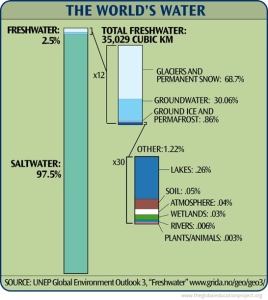
Water is necessary for world peace
The 2024 UN World Water Development Report emphasizes the importance of water security and fair access to water services for peace and development. Building and sustaining wealthy and peaceful communities requires equitable access to water resources, clean and cheap water supply and sanitation services, and their many advantages. Recent worldwide diseases and violent wars have shown that socio-political circumstances for water supply, management, and consumption may change quickly. As climate change and geopolitics affect our water supplies, water management must adapt to new economic and social realities. Leveraging water for prosperity and peace involves non-water initiatives. [2]
Water provides fundamental human needs, supports livelihoods and economic growth, ensures food and energy security, and protects the environment
Economic prosperity refers to the ability of an individual, company, or society to enhance economic performance and living standards, with a focus on countries’ productivity, particularly water productivity, and income equality. Water services enhance social well-being by ensuring clean drinking water, food security, and cultural integrity for all people. Environmental integrity refers to the capacity of the environment to retain biophysical processes and services that enable resilience and security under changing climatic and societal situations. [3]
Global events and disruptions increase water concerns
Climate change, geopolitical turmoil, pandemics, mass migration, hyperinflation, and other disasters may worsen water access inequality. On the other hand, the increase of water concern fosters collaboration and change between organizations. Trends and events generate policy windows to build resilience and adaptability, promoting wealth via water promotes peace. [4]
Water Demand Keeps Increasing
Global water demand is projected to increase by 55% between 2000 and 2050 due to industrial and domestic use. International population expansion and contemporary home technology have increased residential water usage 600% since the 1960s. The visual below shows domestic water withdrawals since 1960:
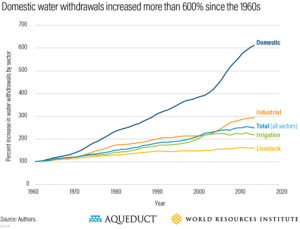
Domestic water consumption comprises public water supplies and self-supplied potable and non-potable water
Indoor and outdoor residential water consumption includes drinking, meal preparation, bathing, washing clothing and dishes, flushing toilets, watering lawns and gardens, and maintaining pools. Domestic water is usually taken from a well or collected as rainwater in a cistern. Only 13% of US home water is private. [5]
Below is a visual on competing water uses (2015). The world has 65.5% water use due to agriculture, 20.8% due to industrial, and 13.7% due to domestic. Low and mid income countries have 65.6% agriculture, 20.9% industrial, and 13.5% domestic. High income countries have 59.9% agricultural, 16.8% industrial, and 23.2% domestic.
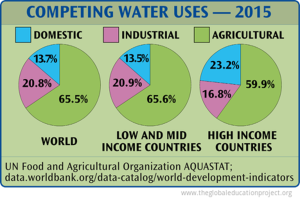
Lack of Water Causes Environmental Shifts
Changes in climate patterns are causing more frequent and severe droughts in many parts of the world, exacerbating water scarcity. For instance, the Horn of Africa has experienced its worst drought in 40 years. [7] About 90% of natural catastrophes are related to water. The effects of floods, droughts, and wars are dwarfed by the deaths and injuries caused by poor drinking water and sanitation. Poor drinking water, sanitation, and hygiene cause 4.0% of fatalities and 5.7% of disability or illness worldwide. [8]
Population Growth Strains Water Resources
Rapid population growth in urban areas is straining water resources. By 2025, it is estimated that 1.8 billion people will live in regions with absolute water scarcity, and two-thirds of the world population could be under water stress conditions. [9]
Who is Most Affected by Water Scarcity and Pollution
The WHO estimates that over 2 billion people—one-fourth of the world’s population—live in water-stressed countries and only have access to contaminated drinking water, which can cause cholera, dysentery, typhoid, polio, and diarrhea. The latter alone kills 485,000 people annually, while unclean water kills 1.2 million, mostly in low-income nations. [10]
People in low-income regions, especially in sub-Saharan Africa and parts of Asia, are most affected by water scarcity and pollution. Lack of infrastructure and investment in water treatment facilities exacerbates these issues. [11] Rural communities often rely on local water bodies for drinking, cooking, and agriculture. Pollution and scarcity directly impact their health and livelihoods. [12] Children are more vulnerable to waterborne diseases caused by polluted water. Women, particularly in developing countries, bear the burden of fetching water, often traveling long distances, which affects their health and productivity. [13]
However, water shortage is not confined to growing nations. Southern European nations like Portugal, Spain, and Italy are currently under water stress, and Spain’s condition will deteriorate by 2050. WRI specialists predict medium to severe water stress in France and Poland, using 20–40% of available resources. Below is a visual of where water will be highly scarce by 2050:
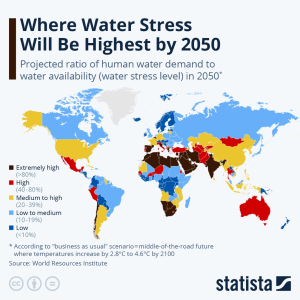
Communicating about water in business responsibly and sympathetically is an opportunity for collaboration, diplomacy, and promoting peace between nations. Uneven distribution of water resources, water supply and sanitation services, and social, economic, and environmental advantages may undermine peace and social stability when discussing water haphazardly.
Water disputes may arise when demand exceeds supply, pollution compromises availability, access to (and distribution of) water is unpredictable, water supply and sanitation services are interrupted, or water management institutions are weak. Water has frequently been a weapon, target, or victim of conflict, but not typically the cause of war. This happens when civilian water infrastructure such as distribution networks, treatment facilities, and dams is attacked. International humanitarian law protects civilian infrastructure, particularly water systems. [15]
Business’s Role in Water Scarcity
Agricultural Demands Keep Increasing
Agriculture accounts for approximately 70% of global freshwater withdrawals. Increasing food production needs continue to put pressure on water resources. [16] One of the biggest water contamination sources is agricultural runoff. Algal blooms generated by excessive nitrogen and phosphorus levels may deplete oxygen in freshwater, rendering it unfit for drinking and killing numerous creatures. Agricultural pesticides and fertilizers cause water body eutrophication and dead zones. [17]
Agricultural practices are not the sole problem. Extractive industries like oil and gas consume plenty of water. When wells fail, wastewater transit leaks, or storage is improperly planned, tainted water may infiltrate the environment. Only North Dakota reported 400 wastewater leaks in 2018. Heavy metals, chemicals, and untreated waste are being discharged into rivers and lakes, leading to toxic water conditions. [18] Organizations discharge 80% of our water back to the environment without sufficient treatment. While low-income nations have a higher rate (92%), even high-income states like the U.S. discharge 30% of water untreated. [19]
Plastic Pollution
Water is typically transported in plastic bottles. Plastic waste, even microplastics, can be found increasingly in water bodies. This not only affects aquatic life but also enters human food chains. [20]
AI and Technology Centers Use an Unsustainable Amount of Water
The growing demand for online services and generative AI products has caused tech giants to drastically increase their water requirements for cooling data centers. Data centers use cooling towers and air mechanisms (thermoelectric plants) to dissipate heat, which results in up to 9 liters of water evaporating for every kWh of energy used for AI server cooling. By 2027, AI’s estimated water consumption could reach 6.6 billion m³, indicating the need to address its water footprint. [21] A 100-word email generated by an AI chatbot using GPT-4 requires 519 milliliters of water, a little more than one bottle. Artificial intelligence has only increased the energy load on data centers, which are also needed to support other operations like cloud computing. Maintaining the servers at a low temperature requires a lot of electricity if a data center is situated in a hot area and uses air conditioning for cooling. Data centers that use water cooling run the risk of depleting a valuable natural resource if they are situated in regions that are prone to drought. A general manager at Microsoft, Craig Cincotta, said the company “remains committed to reducing the intensity with which we withdraw resources.” He added that Microsoft is working towards installing data center cooling methods that “will eliminate water consumption completely.” [22]
The Perils Facing Aquatic Life
Rising Temperatures
Fish, whales, and myriad other aquatic organisms are facing unprecedented threats due to the accelerating impacts of climate change. Rising ocean temperatures, a direct consequence of increased greenhouse gas emissions, are pushing many species beyond their thermal tolerance limits. This warming leads to coral bleaching, which devastates coral reefs—critical habitats and nurseries for a vast array of marine life. As reefs die, entire ecosystems collapse, leaving countless species without food or shelter (Hoegh-Guldberg et al., 2018). Ocean acidification slows the development and maintenance of structures for marine life, especially organisms with shells or skeletons like corals and shellfish, due to increased atmospheric carbon dioxide absorbed by the oceans (Doney et al., 2009).
Sea Level Lising
Sea level rise is also a result of melting glaciers and ice sheets, which changes coastal habitats and endangers species that depend on particular intertidal zones. Marine populations are further endangered by changes in ocean currents and stratification patterns, which also alter migratory routes and nutrient distribution. [23]
Impact on Human Life
The threat to aquatic life highlights the intricate interdependence of all ecosystems and has significant ramifications for humans as well. For example, communities that depend on seafood as their main source of protein and income are at risk, and the decline of fish populations poses a threat to global food security. [24] Healthy oceans control the global climate; their deterioration could increase the frequency of extreme weather events and worsen global warming by absorbing enormous amounts of heat and carbon dioxide. [25] Additionally, marine ecosystems offer vital functions like oxygen production, nutrient cycling, and coastal protection. The loss of mangroves, coral reefs, and other coastal habitats makes human settlements more susceptible to erosion and storms. In addition to supporting a multitude of promising new medications and biotechnological advancements, the delicate balance of marine biodiversity may be permanently lost if species disappear. In the end, the stability and well-being of human societies are closely related to the health of aquatic life.
Businesses Impacting Aquatic Life
Previous chapters have mentioned businesses polluting water such as with industrial discharge, agricultural runoff containing pesticides and fertilizers, pollution from cooling processes, and inadequate management of landfill which can contaminate groundwater.
Another significant way businesses compromise water quality is through microplastic pollution. Synthetic clothing materials like polyester, nylon, and acrylic shed tiny plastic fibers (microfibers) during washing. These microfibers are often too small to be captured by wastewater treatment plants and consequently end up in rivers, lakes, and oceans. Once in aquatic environments, these microplastics are ingested by a wide range of marine organisms, from zooplankton and shellfish to fish and even whales. [26]
Microplastics refers to very small pieces of plastic debris, typically defined as being less than 5 millimeters (0.2 inches) in length. These tiny particles come from a variety of sources, including the breakdown of larger plastic items (e.g., plastic bottles, bags, fishing nets) through weathering and UV radiation, as well as directly manufactured microbeads found in personal care products (though many countries have banned these), and synthetic fibers shed from textiles during washing. Ingesting microplastics can lead to various harmful effects, including physical blockages in digestive tracts, reduced feeding, impaired reproduction, and the transfer of absorbed toxins up the food chain. Businesses in the fast fashion sector, with their emphasis on high-volume production of synthetic garments, contribute significantly to this insidious form of pollution, directly impacting the health and survival of aquatic life globally. [27]
Managing Water Responsibly and Sustainably
The good news is that many businesspeople want more sustainable water management because they realize it’s the best long-term plan for tackling water-related business risk. This enlarged view on water will connect with many private sector firms if the post-2015 development plan includes a comprehensive water target. The UN Millennium Development Goals’s priority for water was access and sanitation to address fundamental human needs, which may only be indirectly tied to corporate interests. [28]
However, the UN-led global debate on water in the post-2015 world has gone beyond defining policy goals for safe drinking water, sanitation, and hygiene. It currently incorporates water resources management, wastewater management, and water quality goals. All sectors of society must work together to meet these two water objectives.
Companies now see the global water problem as a commercial issue and are already acting, frequently alongside stakeholders. Awareness has grown in the previous decade as water shortages have increased worldwide. Water is one of the World Economic Forum’s annual Global issues Report’s top five societal issues for two years (for likelihood and severity). This indicates that mainstream CEOs in numerous business sectors understand water as a substantial danger to their firms, not just a few progressive CEOs or mid-level sustainability professionals at global and medium-sized corporations. [29]
After considering the requirements and interests of other partners, more corporations believe that sustainable water management is the best long-term water risk mitigation plan. Below is a figure to visualize how water is managed as a resource and used in infrastructure. It contains “water governance and management” in the middle. The left half says “catchment water resource” and the right states “water infrastructure system.” Below “catchment water resource” are three circles going in a cycle, starting with “receiving water resources” pointing to “catchment ecosystems” then “upstream water resources.” It points to the first of three circles under “water infrastructure system.” The first circle is “water supply and treatment,” pointing to “company, supplier, and community water uses”, which points to “wastewater and stormwater treatment and discharge.
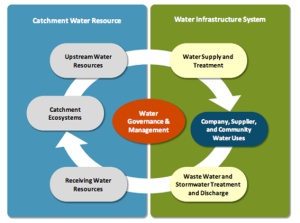
Unsustainable water management threatens governments, civic society, underprivileged people, and others in different but linked ways. Thus, shared water risk motivates corporations and others to improve water management. The private sector uses most worldwide water, including industrial and agriculture-based supply systems. Without commercial assistance, such ambitions may be difficult to achieve.
The Global Water System and Engaging Corporate Governance
The global water system is essential for sustaining life, economic development, and environmental health. However, it faces numerous challenges, including pollution, over-extraction, and climate change impacts. Understanding and addressing these issues require effective communication strategies that inform and engage the public and stakeholders. [31]
Effective communication strategies are necessary to educate the public and stakeholders about the sources of pollution and the importance of mitigation measures. [32] Encouraging industries to adopt cleaner production methods and stricter regulatory compliance can mitigate this issue. Public awareness campaigns about water conservation and proper disposal of hazardous substances can reduce urban water pollution. [33] Businesses can also improve the clarity of expiration labels on water-intensive products can reduce confusion and prevent premature disposal, thus conserving water resources. [34]
Greenwashing Water and Plastic Bottles
Below are a few examples of companies that have greenwashing eco-friendly claims. The first is Coca-Cola claiming its bottles were 30% plant-based and 100% recyclable. PlantBottle uses Brazilian sugarcane ethanol. This sugarcane is cultivated in “degraded pastures located over 2,000 km from the Amazon, so that it has lower impact on biodiversity.” Their website states that their fields “use effective cultivation processes, so the sugarcane is predominantly rain-fed and mechanically harvested.” While knowing that sugarcane ethanol was generated sustainably is reassuring, its distribution techniques are not. Their CO2 emissions contribute to climate change since the aircraft and vessels needed to export goods use jet fuel.
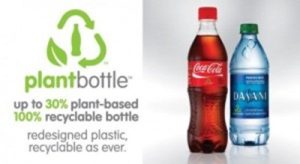
Fiji has also been singled out for its advertising on its water, as though it is finer or better quality due to originating from another country:

Its water didn’t actually begin as a cloud, it did not gather minerals and electrolytes if it is simply water, and it can’t be “untouched by man” in order to be bottled up and shipped to other countries. In fact, although the water is from Fiji, the bottles themselves were made in China.
The claims sound far-fetched, but Fiji does invest its sales into rainforest conservation projects on Fiji in cooperation with the NGO Conservation International. [36] Fiji Water’s website says the company has planted 250 acres of trees in Fiji and has a Fiji foundation, which provides clean water and healthcare services to rural communities, building educational facilities for children and helping disaster relief. They also have a long-term plan to conserve 400,00 acres of rain forest. [37] Below is another image of a Fiji water bottle with the words “Every drop is green. Your Fiji Water purchase helps reduce carbon emissions and protect Fijian rainforests”:
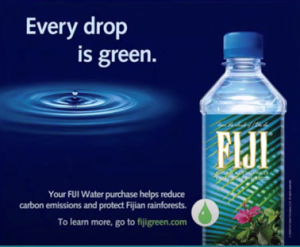
Fiji’s advertising claims were initially misleading due to the environmental impact of using plastic bottles and the need for international transportation. However, the detailed explanations on its website about the company’s contributions to Fiji proved its sustainability claims online. Perhaps the advertising worked to gain publicity while proving its point in detail upon further research. [38]
The truth is plastic is one of the most toxic materials for the environment when wasted, so bottled water greatly contributes to waste and global warming in the long run. No matter how “green” a beverage appears, drinking water from the tap and using re-usable bottles will always be better for the environment. [39]
Case Studies: How Companies have Reacted to Public Demands for Water Justice
Consider a Coca-Cola facility in Kaladera, Rajasthan, India. Local producers pay more for irrigation, drinking water is scarcer, and milk productivity is lower in the plant’s catchment. The 1999 Coca-Cola facility was a major groundwater consumer during a period of groundwater depletion. Before the Coca-Cola factory opened, the Central Ground Water Board declared the region “overexploited” in 1998. Coca-Cola’s presence, a shift toward water-intensive crops and increasing agricultural water usage, population expansion, and urbanization have all contributed to groundwater depletion in Kaladera. Groundwater extraction in Kaladera was 135% of the normal recharge rate in 2006, with agricultural water usage accounting for almost 100%. The plant extracts less than 3% of local water 70% of the time and 1% 40% of the time. As a well-resourced and well-known player that pumps enormous amounts of groundwater, local stakeholders blamed Coca-Cola and wanted the facility closed. [40]
Closing the Coca-Cola plant did not seem to decrease groundwater depletion. Therefore, Coca-Cola invested in watershed projects like rainwater collection to balance its water use via its “water neutrality” policy. This, like many others, demonstrates that Coca-Cola wants to ensure that local water consumers are efficient and that local government can manage water properly to minimize pressure on the corporation and enhance water supply. Coca-Cola supports community water initiatives to replenish its beverage water. Watershed protection, water access, and sanitation programs help local populations maintain water resources. [41] Below is Coca-Cola’s 2030 Water Security Strategy [42]:
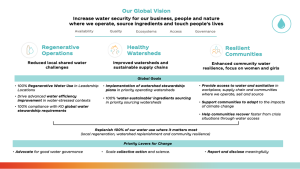
Google’s massive data center in Mesa, Arizona raised water scarcity fears. Residents consumed hundreds of gallons of water per day, whereas Google’s data center uses one million gallons per day to cool, saving electricity. If water usage dropped, energy consumption rose, and vice versa, because water is less expensive than electricity. Since the controversy, Google has reported using recycled or saltwater instead of clean drinking water or depleting local resources. Google claims it saves water by recirculating cooling water. The corporation is developing a water credits scheme with regulators as well. [43]
Nestlé’s efforts have dried out certain waterways, having once taken 45 million gallons of Strawberry Creek spring water from California, and Olympia, Washington, authorities and locals spotted water bottling firms exploiting their water supplies and rules. [44] Nestlé has committed to water stewardship by implementing water-saving measures across its operations and advocating for sustainable water management practices. This includes investing in water-efficient technologies and promoting water conservation among its suppliers and consumers. [45] Nestlé’s water strategy for 2030 can be found here: https://www.nestle.com/sustainability/water/resources-management#:~:text=Our%20strategic%20approach%20to%20water,regenerative%20agricultural%20methods%20by%202030.
The Role of Certifications
Certifications like Water Stewardship Certification (AWS) and LEED (Leadership in Energy and Environmental Design) provide assurance that water management practices meet specific sustainability criteria. These certifications can influence public decision-making and promote more sustainable water use. [46] Below is the logo for Alliance for Water Stewardship as shared by Nestlé Waters.

Businesses’ Shared Interest
In 2020, over 509 investors with $110 trillion in assets demanded that firms publish water security risks, consequences, and actions via CDP (previously Carbon Disclosure Project). Companies, investors, and cities/states/regions use the CDP for global transparency. These inquiries show investors’ worries about water’s impact on long-term profits. Businesses’ stakes are highlighted in a recent CDP report: Inaction on water dangers costs five times more than activity. [47] Investors are beginning to recognize that companies who fail to rethink their business models or implement more water-secure technology and practices will lose money in the long run.
However, as water sustainability affects company productivity, many organizations are reducing their water footprint faster. Many household brands are changing their processes to consume less water or return more water to the environment than required for daily operations.
Companies are increasingly promising water sustainability with net-positive water promises. Therefore, many corporations have vowed to significantly cut water use throughout operations or be net-positive (many by 2030).
Companies may discover patterns and construct water quality and consumption models using remote monitoring, AI, and machine learning. Thus, they will be better able to calibrate processes, comprehend water data from different perspectives, and make proactive choices that save water, enhance efficiency, water quality, and operating costs. [48]
Innovative Water Management Practices
Sustainable water management involves practices that meet current water needs without compromising future generations’ ability to meet theirs. Effective communication of these practices can enhance public trust and promote more sustainable behaviors, as consumers are increasingly aware of water scarcity and pollution concerns. [49]
Traditional water management practices often involve large-scale infrastructure projects like dams and reservoirs. While these have their benefits, they can also lead to significant environmental disruption. Innovative water management includes sustainable approaches, such as rainwater harvesting and greywater systems. [50] Rainwater Harvesting involves collecting and storing rainwater for various uses, reducing the demand on conventional water supplies. This practice can be particularly effective in arid regions and can help mitigate the impacts of droughts. [51] Greywater Systems recycle wastewater from domestic activities such as bathing and washing for non-potable uses like irrigation and toilet flushing. This reduces the overall demand for fresh water and minimizes wastewater generation. [52]
Communicating Sustainable Water Practices
Water waste is a significant issue, with substantial environmental, economic, and social impacts. Communicating strategies to reduce water waste can help raise awareness and encourage more sustainable behaviors. [53]
Water Recovery Hierarchy
The water recovery hierarchy prioritizes actions to reduce water waste, with the most preferred actions at the top. These include reducing water usage, reusing water where possible, recycling wastewater, and disposing of water waste as a last resort. [54]

Above is an image of a pyramid. The largest section on the bottom says “(5) fresh water.” Above it says “(4) regeneration reuse.” The next one above it says “(3) direct reuse/outsourcing of external water.” Above it says “(2) source reduction.” The part on top says “(1) source elimination.” Therefore, top to bottom, the figure starts with source elimination, source reduction, direct use/outsourcing of external water, regeneration reuse, then fresh water.
Are Businesses Just Helping Provide Clean Water for Good Publicity?
One argument against a private sector engagement in sustainable water management is that corporations lack an economic incentive to get involved. [56] This argument suggests that companies are “greenwashing” by making efforts to mitigate adverse impacts from their operations, advance sustainable water management by investing in other actors’ water-use efficiency, or facilitate aquifer recharge schemes. Thus, organizations strive to look responsible for public relations purposes but do not actually serve the public interest. This reasoning suggests that corporate public relations activities cannot solve water sustainability issues in the long run. True, there is no indication that firms will operate in a water-efficient way in the long term. This argument also implies that corporate water sustainability activities are entirely motivated by a desire to be seen as responsible, despite rising evidence to the contrary. [57] It overlooks numerous water-related business risks that generate economic incentives for corporations to participate in sustainable water management across their supply chains and watersheds to assure water security and long-term company viability. Improved water-use efficiency or less wastewater treatment can have its own long-term economic advantages. [58]
Even if companies use press releases for public relations, does not eliminate greenwashing, but it disproves the idea that corporations cannot retain policies and practices that boost their image. Again, the goal is to improve our capacity to distinguish between actual, constructive initiatives and greenwash so we can reward firms making significant progress. [59] The growing concept of “water stewardship” captures this new knowledge and the fact that a business’s water-related concerns can only be properly handled outside the industrial fence-line. [60]
Companies’ water use and commodity output are limited by shortages. Gap Inc. cut their 2011 earnings forecast by 22% due to water shortages in Texas, India, Pakistan, and Brazil. [61] Businesses like energy generation are also affected by water constraint. The 2001 drought and government energy price rules substantially reduced energy production in São Paulo, Brazil. Government quotas cut energy usage 10%–35% to prevent blackouts. Many southeast Brazilian industries lost capacity, delayed output, or raised expenses. [62]
The Alliance for Water Stewardship (AWS) released its water stewardship standard in April 2014, suggesting stakeholders may soon examine a company’s water-related actions. Financial investors are also increasingly looking for organizations that manage short- and long-term water risks and satisfy stakeholder expectations. Over the previous decade, shareholder resolutions on water—mostly from the food, beverage, oil, and chemical industries—quadrupled (Ceres 2009).
Water-related development difficulties and shifting stakeholder expectations provide economic incentives for firms to act responsibly. It’s shortsighted to dismiss these potentially paradigm shifting levers toward corporate sustainability because they diverge from previous corporate actions, especially when the CEO Water Mandate, PSIRU, WWF International, and others are calling for them. Instead, we should explore how these new levers may assist business, communities, and ecosystems, and how to prevent one-sided results and greenwash that undermines such prospects. [63]
How Individuals can Help Reduce Domestic Water Use
We can take the following steps to help reduce domestic water use: [64]
- Install air-cooled equipment instead of water-cooled equipment
- Install water refill stations to reduce the use of single-use water bottles.
- Use certified non-toxic products and less polluting processes.
- Maintain and repair equipment, plumbing, and pipes to prevent leaks.
- Sweep floors, sidewalks, and driveways instead of using hoses.
- Use drip irrigation and drought-resistant plants instead of intensive landscaping.
- Minimize runoff with vegetative buffers or rain gardens.
Conclusion
Water is a vital resource because it underpins every aspect of life, from supporting ecosystems and agriculture to ensuring human health and economic development. This chapter has highlighted the importance of water for our planet, its sustainability, the challenges posed by increasing demand, pollution, and climate change, and the profound impact of scarcity on vulnerable populations. By exploring the roles of individuals, communities, businesses, and governments, we have seen the potential for collective action to address water responsibility and promote sustainable practices. Effective communication strategies are essential in creating a future where water resources are protected and equitably shared. As we move forward, it is imperative that we all take responsibility for our water use, advocate for sustainable practices, and support policies and initiatives that ensure the availability and quality of water for generations to come. Together, we can turn the tide on water scarcity and build a more sustainable and resilient world.
[1] Fresh Water. Global Education Project Earth. From https://www.theglobaleducationproject.org/earth/fresh-water.php
[2] Water – at the center of the climate crisis | United Nations. (2024). United Nations. https://www.un.org/en/climatechange/science/climate-issues/water?gad_source=1&gclid=CjwKCAjw4_K0BhBsEiwAfVVZ_xyhYSDO31Q3dHUBFFluzh2wJkWH9A09b6AaSTLCIcG27XX_0O4UghoCACsQAvD_BwE
[3] Water – at the center of the climate crisis | United Nations. (2024). United Nations. https://www.un.org/en/climatechange/science/climate-issues/water?gad_source=1&gclid=CjwKCAjw4_K0BhBsEiwAfVVZ_xyhYSDO31Q3dHUBFFluzh2wJkWH9A09b6AaSTLCIcG27XX_0O4UghoCACsQAvD_BwE
[4] Water for Prosperity and Peace. (2024). UNESCO. https://www.unesco.org/reports/wwdr/en/2024?hub=418
[5] Domestic Water Use | U.S. Geological Survey. (2023, November 1). https://www.usgs.gov/mission-areas/water-resources/science/domestic-water-use
[6] UN Food and Agriculture Organization AQUASTAT; data.worldbank.org/data-catalog/world-development-indicators and https://www.theglobaleducationproject.org/earth/fresh-water/competing-water-uses-2015
[7] Food and Agriculture Organization of the United Nations (FAO). (2023). Drought and its Impacts on Agriculture.
[8] UN World Water Development Report, 2019: www.unesco.org/water/wwap
WHO, Health and sustainable development; www.who.int/sustainable-development/cities/health-risks/water-sanitation
[9] World Health Organization (WHO). (2023). Global Water Stress and Scarcity.
[10] Igini, M. (2023, June 21). World Faces 40% Shortfall in Freshwater Supply by 2030, Experts Warn Ahead of UN Water Conference. Earth.Org. https://earth.org/freshwater-supply-shortage/
[11] United Nations International Children’s Emergency Fund (UNICEF). (2022). Water Scarcity and its Impact on Children.
[12] World Bank. (2023). Water in Agriculture.
[13] UN Women. (2023). The Impact of Water Scarcity on Women and Girls.
[14] Armstrong, M. (2024, March 22). Where Water Stress Will Be Highest by 2050. Statista Daily Data. https://www.statista.com/chart/26140/water-stress-projections-global/
[15] Water for Prosperity and Peace. (2024). UN World Water Development Report. https://www.unesco.org/reports/wwdr/en/2024?hub=418
[16] World Bank. (2023). Water in Agriculture.
[17] Food and Agriculture Organization of the United Nations (FAO). (2023). Drought and its Impacts on Agriculture.
[18] Draft resolution on effective and inclusive solutions for strengthening water policies to achieve sustainable development in the context of climate change, biodiversity loss and pollution. (2024). United Nations Environment Assembly. From https://docs.un.org/en/UNEP/EA.6/L.16
[19] Ryder, G. (2017). Wastewater: the untapped resource. The United Nations World Water Development Report. https://unesdoc.unesco.org/ark:/48223/pf0000247153
[20] World Wildlife Fund (WWF). (2023). Plastic Pollution in Aquatic Systems.
[21] Gordon, C. (2024). AI is accelerating the loss of our scarcest natural resource: water. Forbes. From https://www.forbes.com/sites/cindygordon/2024/02/25/ai-is-accelerating-the-loss-of-our-scarcest-natural-resource-water/
[22] Verma, P., & Tan, S. (2024). bottle of water per email: the hidden environmental costs of using AI chatbots. Washington Post. From https://www.washingtonpost.com/technology/2024/09/18/energy-ai-use-electricity-water-data-centers/
[23] Poloczanska, E. S., Brown, C. J., Sydeman, W. J., et al. (2013). Global imprint of climate change on marine life. Nature Climate Change, 3(10), 919–925.
[24] Golden, C. D., Allison, E. H., Cheung, W. W. L., Erickson, M. C., Frolich, E. H., Levy, M. A., Mills, D., Swartz, W., & Myers, S. S. (2016). Nutrition: Fall in fish catch threatens human health. Nature, 534(7607), 317–320.
[25] Sarmiento, J. L., & Gruber, N. (2006). Ocean biogeochemical dynamics. Princeton University Press.
[26] Lusher, A. L., Hernandez-Milian, G., O’Brien, J., Berrow, S., O’Connor, I., & Newton, S. (2017). Microplastic and mesoplastic ingestion in a deep-diving, pelagic feeder: The basking shark Cetorhinus maximus. Environmental Pollution, 230, 111–118.
[27] What are microplastics? (n.d.). National Ocean Service. https://oceanservice.noaa.gov/facts/microplastics.html
[28] Goal 6: Ensure access to water and sanitation for all. (2023). United Nations. From https://www.un.org/sustainabledevelopment/water-and-sanitation/
[29] 8 Organizations Making a Difference in Global Water Issues. (n.d.) Seametrics. From https://www.seametrics.com/blog/water-organization-issues/
[30] Morrison, J. (n.d.). Can business help achieve water sustainability goals beyond 2015? | GreenBiz. Retrieved July 20, 2024, from https://www.greenbiz.com/article/can-business-help-achieve-water-sustainability-goals-beyond-2015
[31] Gleick, P. H. (2014). Water, drought, climate change, and conflict in Syria. Weather, Climate, and Society, 6(3), 331-340.
[32] Khatri, N., & Tyagi, S. (2015). Influences of natural and anthropogenic factors on surface and groundwater quality in rural and urban areas. Frontiers in Life Science, 8(1), 23-39.
[33] Satterthwaite, D. (2016). The links between poverty and the environment in urban areas of Africa, Asia, and Latin America. The Annals of the American Academy of Political and Social Science, 590(1), 73-92.
[34] O’Rourke, D. (2014). The science of sustainable supply chains. Science, 344(6188), 1124-1127.
[35] Environmental Communication Greenwashing Critiques. (n.d.) St Lawrence University. https://blogs.stlawu.edu/greenwashingcritiques/green-products/bottled-water/#:~:text=Fiji%20water%20is%20another%20campaign,its%20%E2%80%9Cenvironmentally%20conscious%E2%80%9D%20product.&text=Media%20skews%20the%20way%20we,bombarded%20with%20advertisements%20and%20commercials.
[36] Fiji. (n.d.). https://www.conservation.org/places/fiji#:~:text=CI%20is%20working%20to%20secure,to%20more%20than%20330%2C000%20people
[37] Fiji Water Foundation. (n.d.). https://www.fijiwaterfoundation.org/
[38] ECWQ. (2025). Fiji & Wonderful Company Lawsuit Over Deceptive Ads. East Coast Water Quality. From https://eastcoastwaterquality.com/news/fiji-wonderful-company-lawsuit-over-deceptive-ads/
[39] Vasarhelyi, K. (2023). The Impact of Plastic on Climate Change. University of Colorado Boulder Environmental Center. From https://www.colorado.edu/ecenter/2023/12/15/impact-plastic-climate-change
[40] The Business Case for Investing in Sustainable Water Management. (n.d.-b). https://ceowatermandate.org/sharedchallenges/business-case/
[41] Coca-Cola Reports Fourth Quarter and Full-Year 2021 Results. (n.d.). The Coca-Cola Company. https://investors.coca-colacompany.com/news-events/press-releases/detail/1046/coca-cola-reports-fourth-quarter-and-full-year-2021-results
[42] Water Security Strategy. (n.d.). https://www.coca-colacompany.com/media-center/2030-water-security-strategy
[43] Bloomberg, N. S. (2020, April 2). The Secret Cost of Google’s Data Centers: Billions of Gallons of Water to Cool Servers. TIME. https://time.com/5814276/google-data-centers-water/
[44] Tsui, J. (2020). Big Corporations Contribute to Water Shortages—How can they Fix it? EP Online. https://eponline.com/articles/2020/06/03/big-corporations-contribute-to-water-shortages-how-can-they-fix-it.aspx
[45] Nestlé. (2020). Nestlé commitment on water stewardship. Retrieved from https://www.nestle.com/csv/planet/water
[46] Alliance for Water Stewardship. (2019). AWS International Water Stewardship Standard. Retrieved from https://a4ws.org/
[47] Global Water Report 2020. (n.d.). https://www.cdp.net/en/research/global-reports/global-water-report-2020
[48] Sankaran, M. (2022, May 3). Water sustainability: What companies are promising and how they can deliver. Water Technology. https://www.watertechonline.com/process-water/article/14275867/water-sustainability-what-companies-are-promising-and-how-they-can-deliver
[49] Falkenmark, M., & Rockström, J. (2004). Balancing water for humans and nature: The new approach in ecohydrology. London: Earthscan.
[50] Foster, S., & Chilton, P. J. (2003). Groundwater: The processes and global significance of aquifer degradation. Philosophical Transactions of the Royal Society B: Biological Sciences, 358(1440), 1957-1972.
[51] Gould, J., & Nissen-Petersen, E. (1999). Rainwater catchment systems for domestic supply: Design, construction, and implementation. London: ITDG Publishing.
[52] Eriksson, E., Auffarth, K., Henze, M., & Ledin, A. (2002). Characteristics of grey wastewater. Urban Water, 4(1), 85-104.
[53] Lundqvist, J., de Fraiture, C., & Molden, D. (2008). Saving water: From field to fork—Curbing losses and wastage in the food chain. SIWI Policy Brief. Stockholm: Stockholm International Water Institute.
[54] EPA. (2012). Food recovery hierarchy. Retrieved from https://www.epa.gov/sustainable-management-food/food-recovery-hierarchy
[55] Wan Alwi, Sharifah Rafidah & Manan, Zainuddin & Samingin, M. & Misran, Norbahiah. (2006). BENCHMARKING WATER UTILISATION USING MINIMUM WATER NETWORK TECHNIQUE. https://www.researchgate.net/publication/242256136_BENCHMARKING_WATER_UTILISATION_USING_MINIMUM_WATER_NETWORK_TECHNIQUE
[56] Hall, D., & Lobina, E. (2012). Conflicts, Companies, Human Rights and Water—A Critical Review of Local Corporate Practices and Global Corporate Initiatives. University of Greenwich. Public Services International Research Unit. http://www.world-psi.org/sites/default/files/documents/research/psiru_conflicts_human_rights_and_water.pdf
[57] Carbon Disclosure Project. (2012). Collective Responses to Rising Water Challenges. CDP Global Water Report 2012. Authored by Deloitte. https://www.cdproject.net/CDPResults/CDP-Water-DisclosureGlobal-Report-2012.pdf
[58] Ceres. (2009). Water Scarcity and Climate Change: Growing Risks for Businesses and Investors. PACINST. http://www.pacinst.org/reports/business_water_climate/full_report.pdf
[59] https://ceowatermandate.org/sharedchallenges/business-case/
[60] Hepworth, N., & Orr, S. (2013). Corporate Water Stewardship—New Paradigms in Private Sector Water Engagement. In B.A. Lankford, K. Bakker, M. Zeitoun, and D. Conway (eds.), Water Security: Principles, Perspectives and Practices. London: Earthscan Publications.
[61] Larson, W.M., Freedman, P.L., Passinsky, V., Grubb, E., and Adriaens, P. (2012). Mitigating Corporate Water Risk: Financial Market Tools and Supply Management. Water Alternatives 5(3): 582–603.
http://www.limno.com/pdfs/2012_Larson_WatAlt_Art5-3-5%5B1%5D.pdf
[62] CLSA. 2006. Remaining Drops: Freshwater Resources, A Global Issue. Hong Kong: CLSA Bluebooks.
[63] The Business Case for Investing in Sustainable Water Management. (n.d.). https://ceowatermandate.org/sharedchallenges/business-case/
[64] Water Sustainability: What It Means for Your Business. (2024). Green Business Benchmark. From https://www.greenbusinessbenchmark.com/archive/water-sustainability-for-business